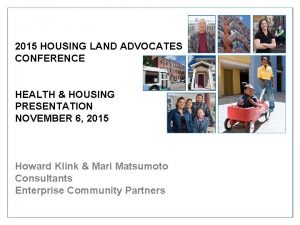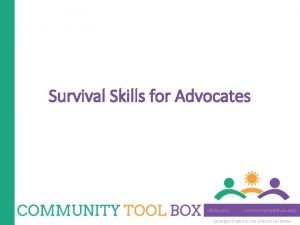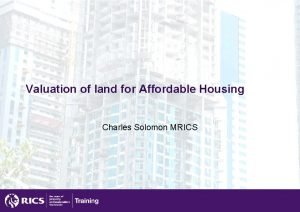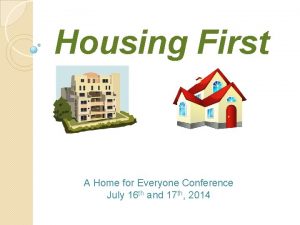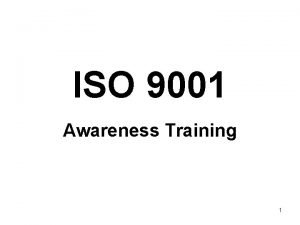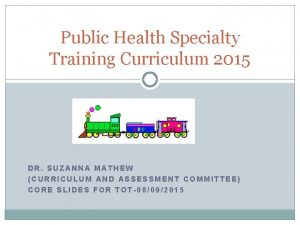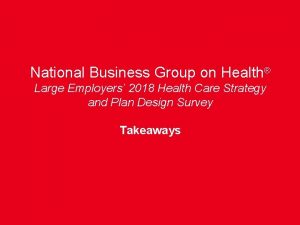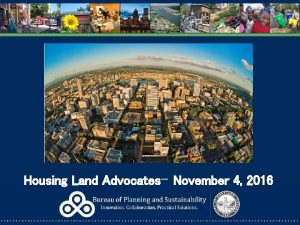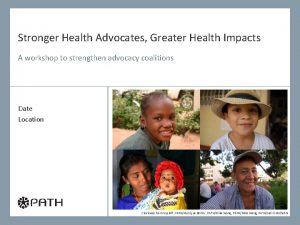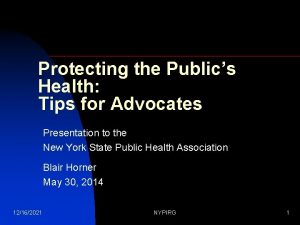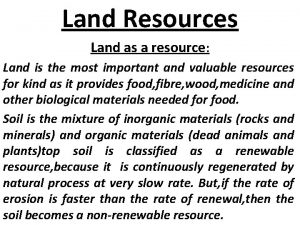2015 HOUSING LAND ADVOCATES CONFERENCE HEALTH HOUSING PRESENTATION




















- Slides: 20

2015 HOUSING LAND ADVOCATES CONFERENCE HEALTH & HOUSING PRESENTATION NOVEMBER 6, 2015 Howard Klink & Mari Matsumoto Consultants Enterprise Community Partners

ENTERPRISE v National non-profit v Mission: To create opportunity for low- and moderate-income people through affordable housing and diverse, thriving communities. v Achieved by Low Income Housing Tax Credits (LIHTC), pre-development, acquisition and bridge loans; grants to community development corporations; public policy v Invested $1+ billion in OR + WA to create or preserve 30, 000 affordable homes. v National & local initiatives: partner sustainability, green communities, equitable transit oriented development, community revitalization, rural/Native American, health & housing 2

WHY LINK HEALTH & HOUSING? v Health systems are being held increasingly accountable for population health. v Housing is a recognized social determinant of health. v Our housing residents have considerable health care needs. v Changes at Oregon Housing and Community Services encourages connections with other departments, such as health, education and transportation. v Affordable housing may be an option for policy makers looking for innovative ways to improve utilization patterns and reduce costs. v Oregon is leading with coordinated, prevention-focused models. 3

Social Determinants of Health v Circumstances in which people are born, grow up, live, work and age, and the systems put in place to deal with social well-being, health and illness. These circumstances are in turn shaped by a wider set of forces: distribution of money, power and resources at global, national and local levels. -World Health Organization 4

Health Equity v Health equity is achieving the highest level of health for all people. Health equity entails focused societal efforts to address avoidable inequalities by equalizing the conditions for health for all groups and communities, especially for those who have experienced socioeconomic disadvantage or historical injustices related to poverty, race, ethnicity, tribal affiliation, age, gender, education, disability or sexual minority status. From Healthy People 2020 (mostly) 5

HEALTH AND HOUSING LEARNING COLLABORATIVE v Peer-to-peer collaborative of 9 affordable housing organizations and health care stakeholders (mental, behavioral, physical) in Portland. v Participating organizations: Cascadia Behavioral Health, Catholic Charities, Cedar Sinai Park, Central City Concern, Home Forward, Human Solutions, Innovative Housing, Inc. , Northwest Housing Alternatives, REACH CDC. v Pilot programs that increase linkages between affordable housing and health, increase capacity of housing owners, build partnerships between health and housing fields. v Activities: 6 v Develop culturally appropriate service delivery models v Enhance relationships with Coordinated Care Organizations (CCOs), hospitals and insurers v Develop sustainable, replicable program models v Develop resident health screening tools v Share best practices v Impact health and housing policy v Measure impact of affordable housing on residents’ health outcomes via longitudinal study run by Providence’s CORE (Center for Outcomes Research and Education)

CORE STUDY – OBJECTIVES v One-year longitudinal study assessing impact of housing & integrated services on health care costs and quality outcomes. v Objectives v Understand how housing impacts outcomes for different kinds of clients. v Assess impact of stable housing on Medicaid utilization, cost, quality, and health outcomes. v Assess specific impact of integrated services and staff as drivers of health outcomes. What services matter most, and to whom? 7

CORE STUDY - OUTCOMES v v 8 Survey v Prevalence of self-reported chronic conditions are well above the national average v Most pronounced unmet needs are in dental and mental health v Data indicates an awareness gap at sites that have on-site services v Residents report significant improvements in access to care and quality of care after moving into their new housing site Medicaid Claims Analysis v Cost to health care systems was lower after people moved into affordable housing ($48 PMPM Medicare savings). v Primary care visits went up (+20%) after move-in; emergency department visits went down (-18%). v Residents reported that access to care and quality of care improved after moving into housing. v Integrated health services were a key driver of outcomes, even though awareness was low.

WHAT DOES IT ALL MEAN? v Access to stable, affordable housing will likely drive down costs to the health care system. v Affordable, stable housing helps meet major health reform utilization metrics such as reduced emergency department visits and increased primary health care usage. v Decreasing costs doesn’t need to come at the expense of health access or quality. v Integrated health services may increase the benefits of housing to residents and health care systems. 9

Housing with Services Portland, Oregon Version 2. 0 A Work in Progress Presented by Howard Klink; Housing with Services Project Director Klink Consulting Group

Housing with Services: 20102013 2010 Cedar Sinai Park, initiates discussion of an integrated service model with local human service providers and state officials. 2011 The concept is formally presented in Salem and receives enthusiastic endorsements from the state Department of Human Services and Oregon Health Authority. 2012 - 2013 Initiative moves forward, attracting national attention, with private and federal funding, and a collaborative partnership of interested stakeholders.

Housing with Services- FUNDING SOURCES TO DATE Enterprise Communitie s– Vulnerable Populations Grants $75, 000 Housing with Services LLC Partner Equity Contribution s $335, 000 Centers for Medicare and Medicaid Services – State Innovation The Harry and. Model Grant Jeanette $440, 000 Weinberg Foundation, Inc. Health Center Construction Grant $430, 000 HEDCO Foundation Grant to assist in Care Center Construction $60, 000 $1, 340, 00 0

Housing with Services - GOALS ØImproved health outcomes ØReduced costs ØDelayed entry or re-entry into institutional care ØIncreased resident and community engagement ØSustainability through health care stakeholder support ØIncreased access to mental health, addiction

Participating Buildings

Services Delivery Model ØResident Services Coordinators ØHealth Navigators ØHealth and Wellness Center ØPrimary and urgency care ØProvidence Elder. Place PACE Program ØPrescription Medication

Services Delivery Model- cont’d ØCulturally Specific Outreach and Navigation ØSite-based Mental Health and Addiction Services ØGive 2 Get (Resident Services Exchange) ØFood Insecurity Prevention and Intervention ØInter-agency Agreement among


What’s in it for the Health Care System? ØCommunity Benefits investment ØSupport for program innovation ØAccess to research and evaluation data ØImproved individual and population health outcomes. ØReduced health care costs. ØAlignment with ACA mandates

Where Do We Go From Here? ØMaintain a strong focus on social determinants of health and health equity. ØHousing people need to learn how to speak health. ØHealth people need to learn to speak housing. ØDevelop the capacity to make the case that you can improve health outcomes and reduce costs. ØSuccessfully engage health care reform stakeholders. ØCommit to meaningful resident engagement in project development, implementation and

THANK YOU! v Howard Klink Project Director, Housing with Services Klink Consulting Group hklink@Comcast. net v Mari Matsumoto Health & Housing Consultant Enterprise Community Partners mmatsumoto@enterprisecommunity. org 20
 Housing land advocates
Housing land advocates Survival skills for advocates
Survival skills for advocates Khurana & khurana advocates and ip attorneys (delhi branch)
Khurana & khurana advocates and ip attorneys (delhi branch) Khurana & khurana advocates and ip attorneys
Khurana & khurana advocates and ip attorneys Early ob advocates
Early ob advocates It advocates orderly approach to software engineering
It advocates orderly approach to software engineering Goggletranslate
Goggletranslate Led conference 2015
Led conference 2015 Ulvan
Ulvan Insight 2015 conference
Insight 2015 conference An area of land largely enclosed by higher land
An area of land largely enclosed by higher land Identifying landforms
Identifying landforms Valuing land for social housing
Valuing land for social housing Nc affordable housing conference
Nc affordable housing conference Housing first partners conference
Housing first partners conference Iso 9001 presentation
Iso 9001 presentation Iso 9001 presentation
Iso 9001 presentation Fph curriculum 2015
Fph curriculum 2015 Iuss guidelines
Iuss guidelines Effect on human health of land pollution
Effect on human health of land pollution National business group on health conference 2018
National business group on health conference 2018
